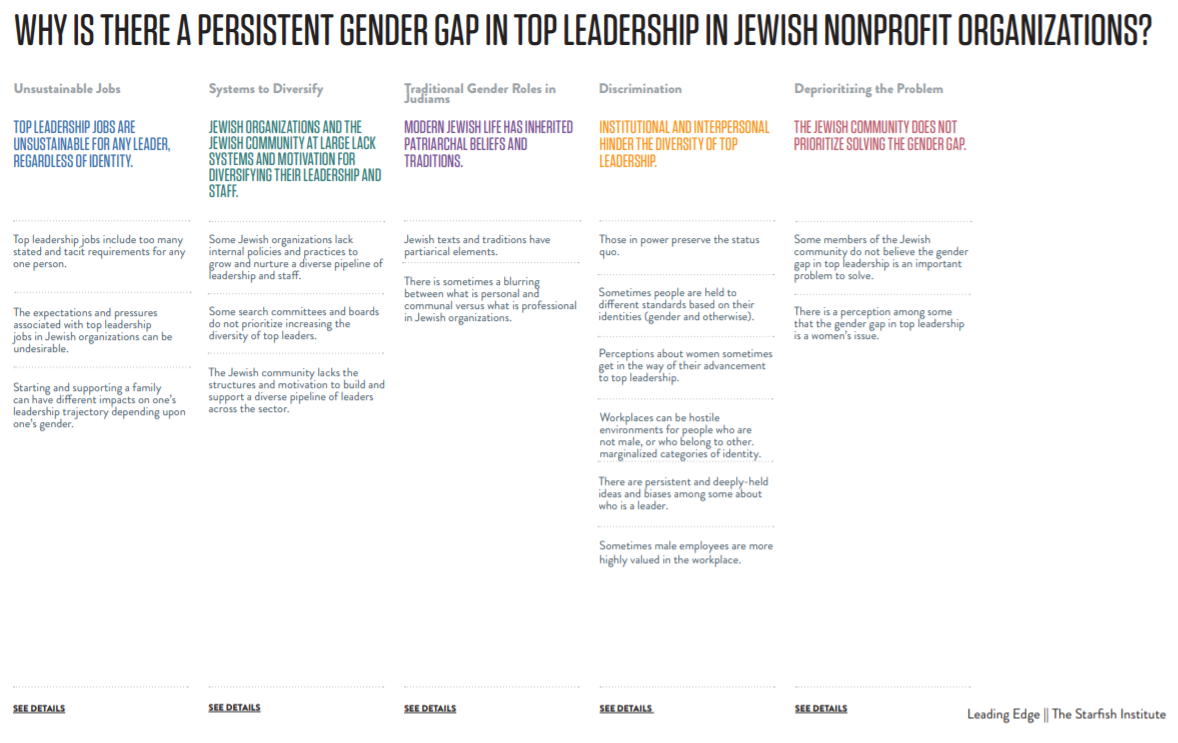Mapping the Problem: A Leading Edge Case Study
Our most complex problems have persisted in no small part because they are the result of myriad and interconnected challenges that have never been fully understood, let alone addressed. But what if we had a way of seeing the whole problem, including its root causes and the areas on which to focus for greatest impact?
At The Starfish Institute, we create comprehensive, crowd-sourced system maps of complex problems. These maps not only give a 360-degree view of the problem and insight into why it has persisted, but also identify a small set of high-leverage opportunities with the greatest potential to impact the system. As a result, networks and individual players are able to see social issues more clearly, holistically, and thoroughly, and make strategic decisions about where to focus resources and action.
Case Study: Mapping the Gender Gap in Top Leadership in Jewish Nonprofit Organizations
In late 2019, The Starfish Institute partnered with the organization Leading Edge to map the root causes of the gender gap in top leadership in a subset of the nonprofit sector: Jewish non-profits. Most people working at Jewish nonprofits are women. But most CEOs of Jewish nonprofits—especially at the largest organizations—are men.
The Challenge: Through building the leadership pipeline for the Jewish nonprofit sector, Leading Edge found that the Jewish community — like many others — continues to privilege a certain traditionally-white cisgender male model of leadership. The problems the sector faces are big, complex, and varied, and will require all of its talent and potential to address them.
Building on the groundbreaking work of Shifra Bronznick (Advancing Women Professionals and the Jewish Community), the SRE (Safety Respect Equity) Network and others, Leading Edge partnered with The Starfish Institute to take a systemic approach toward analyzing the persistent gender gap. Across many dimensions, the project strove to keep in full view the ways that barriers to top leadership overlap across lines of gender, race, ability, class, and more.
The Result: We designed a range of opportunities to gather the perspectives of more than 1,000 people, from across and beyond the Jewish communal landscape, to share their perspective and expertise on the root causes of this issue. These opportunities ranged in duration and intensity, from in-person, half-day workshops to peer-led listening sessions to surveys. From this emerged a full picture of the reason for the persistent gender gap in leadership, broken down into ~75 root causes and organized into five themes.
We then identified the highest-leverage places for impact, which we call “keystones.” Like keystone species in natural ecosystems, these issues are able to keep a system in check and solving them will have a large ripple effect across the system. We distilled five keystones:
Systems to Diversify:
Boards, funders, or other constituents don’t always hold Jewish organizations accountable for addressing the diversity of their top leadership.
A meaningful number of Jewish organizations have no personnel strategy for diversity, equity, inclusion, and justice (DEIJ).
A meaningful number of search committees and boards hold biases about what makes a qualified leader.
Discrimination:
There is a perception that you cannot be both a top leader and a primary caregiver.
Deprioritizing the Problem:
Men don’t always speak out about the gender gap in top leadership.
This map will enable Leading Edge to apply a gender equity lens across all of its efforts and know where to focus resources for the greatest impact. It will also be a powerful tool for the field to understand and tackle the persistent gender gap in top leadership at Jewish organizations, including how it intersects with race, ability, class, and more.
Learn More:
Read Leading Edge’s report: “The Gender Gap in Jewish Nonprofit Leadership: An Ecosystem View”
Check out what The Chronicle of Philanthropy and eJewishPhilanthropy had to say about the report
The Experience: “For the past year, Leading Edge has been honored to partner with the Starfish Institute to tackle the persistent gender gap in top leadership at Jewish organizations. We could not have asked for a better partner. From day one, they have made us smarter, while running an incredibly smooth process. I have never worked with a partner who manages to combine the ‘head’ and the ‘heart’ in such an impeccable way. Their methodology is powerful and strong. Their team pushes you to think more expansively and boldly. They are so incredibly rigorous; data-driven; intellectually powerful. Yet they are also attuned to the interpersonal nature of this work and the role that relationships play in mobilizing a sector to tackle a core challenge. Most importantly, the Starfish team has proven to be the best kind of learning partner -- one that teaches you while also being incredibly open to new insights and circumstances. We have relished being on this journey together.”
Gali Cooks, President & CEO, Leading Edge
Mordy Walfish, COO, Leading Edge


